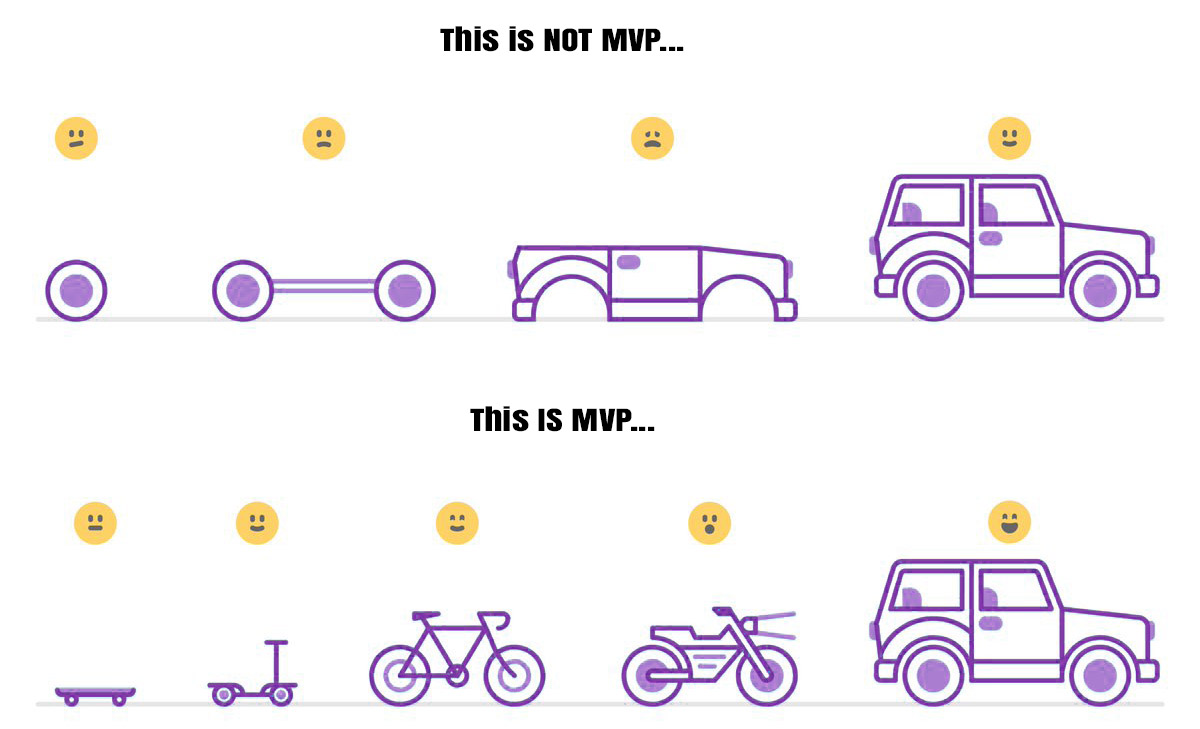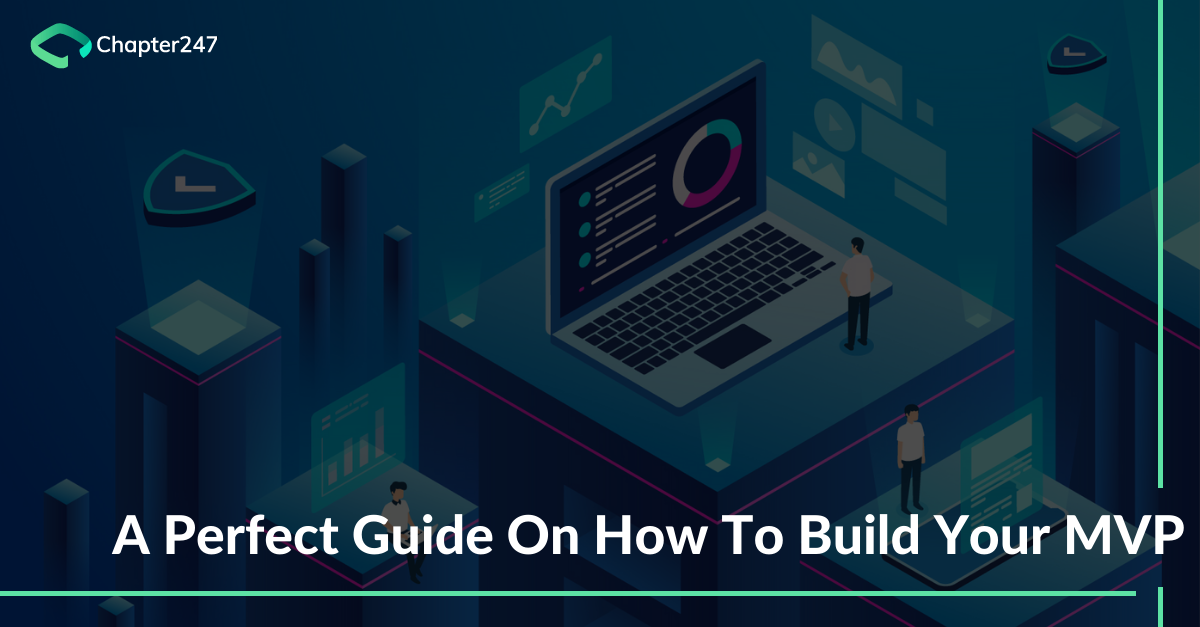What happens when you have a revolutionary idea but are baffled on how to implement it?
The greatest of the ideas can be reduced to nothing if it doesn’t get converted into something perceptible. The maximum one can do is to reduce the risk quotient by first developing a Minimum viable product to get started.
A Minimum Viable Product (MVP) is the stepping stone for idea validation. Many businesses tend to avoid this step but there are the smarter ones who avoid double trouble later and build MVPs.
An MVP is considered the first step of custom software development as it is the product’s test version. There is no rush to implement your idea immediately, but one can first focus on creating the core idea first. With continuous updates and developments, your MVP will gradually evolve before it turns into a full-fledged product.
With several MVP development projects, we have worked on and are still working, we are adept at deciding which steps you need to take towards creating an MVP and march ahead.
Why the product owners need an MVP
MVP is supposed to have
- Value for end-users so that they use it frequently
- Future potential
- Regular feedback to guide future developments
These features will help developers to understand if they are in the right course and will enable the product owner to get the initial reaction to a set of software features. It is less expensive to gather insights from MVP than going all the way to product development i.e. releasing the end product with more features.
Building an MVP can be tough and if you are not confident enough, have Chapter247 develop it for you. With our extensive knowledge gained by our years of development and strategization, develop the best MVP.

Source: Clariontech
 Key steps required to build your MVP
Key steps required to build your MVP
Identification of target markets and segments
The first step will be to determine the target base and get an understanding of their needs by conducting market research, interviews, and preliminary studies. It is crucial also to investigate competition in order to understand what is currently available in the market and how customers are responding to it.
Identification and prioritization of features
There are several frameworks available that can divide the features into must-haves, should-haves, could-haves and won’t-haves. By the end of this step, you will have one top priority feature which conveys the core product value.
The selection of approach
This is not merely a selection from a group of approaches, but the challenge here is to pick from the most appropriate MVP approaches given as below:
No Product
Product-Mock-up
Single feature MVP
MLP
Whatever you decide to choose, should be validated against the idea and the resources available.
 Understand from the User’s shoes
Understand from the User’s shoes
It is important to understand where the user will be using the product, how they will be using it and for what purposes they will be using it. This will enable you to get a 360-degree user perspective.
Experience should follow the KISS(Keep it straight and simple) principle
The unnecessary complication of the task will only force you to go back to step 1, hence it is impossible to focus on keeping every task basic so that it is easy to attain. If people find it cumbersome to use the product, they will move away from it.
Story Map preparation
Immediately after the step identification, a story map has to be prepared for advanced prioritization of features and breaking them down to product backlog. There are 4 major components of story mapping called:
- Goals
- Activities
- User stories
- Tasks
Goals form the backbone of product vision and these goals can be achieved by performing specific activities. These activities need the implementation of different features and tasks which can be converted further into user stories. With the story map formed, you will have a great set of tools to understand the pain as well as gain the method.
MVP launch
Once you have understood how to build MVP and prepared for launch, half the battle has been won. The other half is where you need to construct a fine-tuned analysis of actionable product metrics.
Metrics to determine the success of MVP
Once the MVP has been built and launched, it is now essential to approach the users for relevant feedback and validation. We have listed out key metrics that will help you determine the success.
Feedback
There is nothing as important as customer feedback.True feedback can be gained by interviewing customers. According to the feedback, you can list the problems to be rectified and expectations to be met to ensure the product is made the right way.
Net Promoter score
Popularly known as NPS, this is a survey-based metric. In this, you need to enquire directly from the user about how good they found your MVP. A score interval from 0 to 10 is given which are divided into detractors( score 0 to 6), passives (7 and 8) and promoters ( 9 – 10). NPS can be calculated as the percentage difference between promoters and detractors. A successful NPS score is when you achieve a higher percentage.
Activations
This is all about how good the first experience of the user is. If the number of sign-ups is increasing it is quite apparent that the product is doing well. If new users are not getting added in the loop then you have to find out the reasons, most of the time it is to do with poor UX.
| How our MVP transformed into a brilliant end-product Building an MVP is an essential element in all our projects. A chatbot development platform project we undertook stands the test of time only because of the brilliant combination of MVP feedback and superior product evolution. The client wanted us to build a chatbot creation platform that will enable its users to create chatbots for their business activities. Upon several discussions and agreements, an MVP was launched with the following features
After receiving rave reviews and user feedback, MVP was later converted into a full-fledged solution that had many more features inbuilt namely
We achieved a brilliant and futuristic platform for chatbot creation and building an MVP for feedback was a crucial part of the software development process. Read more to see the creation! |
MRR
Money-based data also can be a great metric to be taken into account. MRR or Monthly recurring revenue is one of the important financial metrics for every SaaS product. This depicts the volume of money the product will generate per month. This revenue comprises a direct income with plausible upgrades (downgrades), churns, discounts, reactivations and much more.
ARPU
Average Revenue per user is a metric that is usually employed to track the growth progress of the company. For MVP, this metric will show much you can expect to get from every user and make relevant tweaks if required. Under this, you will need to divide the total revenue with the number of users.
What’s the next step?
Once the MVP is launched there are obviously two scenarios: either you are successful or not successful.
If your MVP is successful: Your metrics show that the performance has either equaled or exceeded the performance parameters. With this, you can easily expect a growth in the customer base, get the relevant feedback on improving user experience and increased user engagements. The next step should be oriented towards development to promote the product in the market.
If MVP is not successful: Very few startups manage to get it right the first time, but if you have experienced a low-performance metric that does not mean you have lost the battle. It only implies that you need to change the direction of the idea or maybe even the business model. And we believe that it is better to get to know it at the MVP stage than forgoing this and realizing it when your end-product fails.
The Bottom Line
In order to develop an MVP for your product, you may face difficulties with respect to the implementation. Considering the type, features, and risks, you have to think of smarter ways to shrink the concept without forgoing its appeal.
Yes, that is indeed challenging but once you get the balance and hit the market with the first version, further evolution will convert it into a viable product the customers always wanted!
| Got a product idea? Get ready to give it life. Consult our adroit software development professionals right away! |








